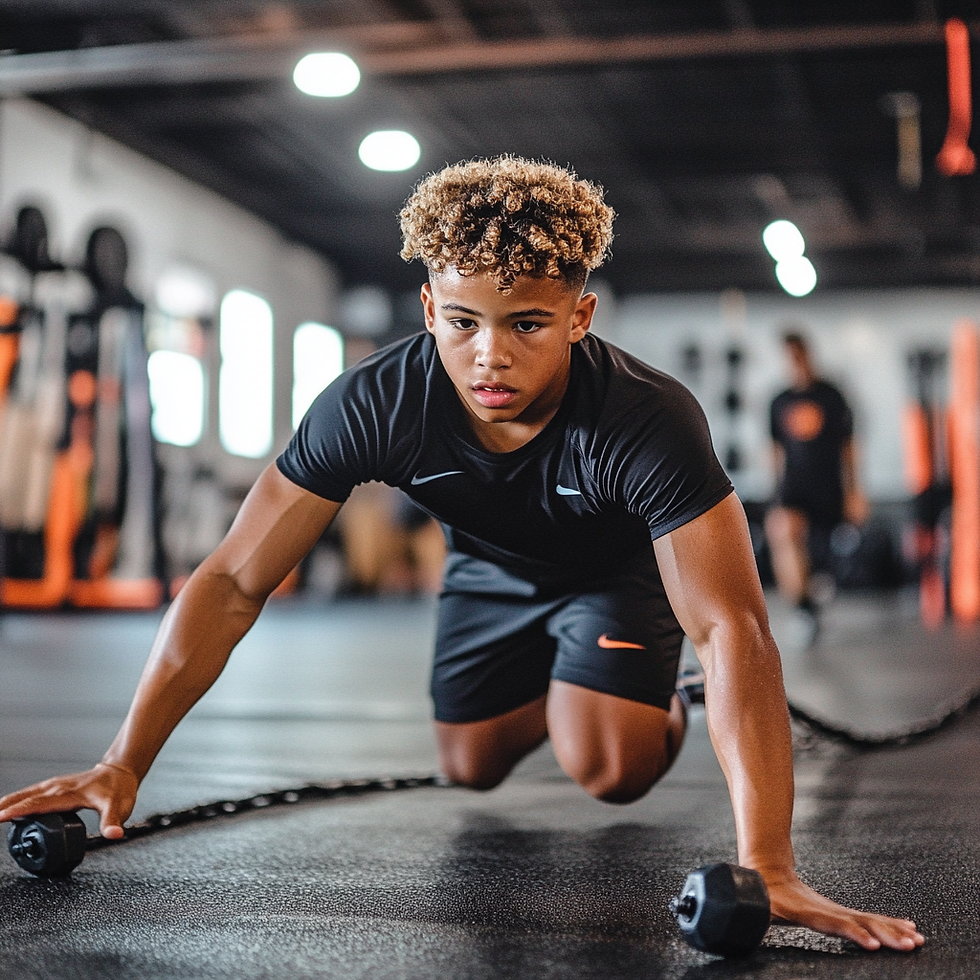How to Bulk Up: Nutrition & Training Tips for Teen Athletes
- Dérik
- Apr 30
- 4 min read

Why Teen Athletes Should Learn How to Bulk Up Safely
Bulking up is a common goal for many teen athletes looking to improve performance, increase strength, or prepare for weight-class sports. However, doing it the wrong way—through excessive eating, supplements without guidance, or overtraining—can lead to injury, poor body composition, or long-term health issues. Learning how to bulk up the right way ensures safe muscle growth, optimized recovery, and enhanced athletic potential.
According to the American Academy of Pediatrics, youth athletes benefit most from structured resistance training paired with adequate calorie and protein intake (AAP, 2020).
How to Bulk Up with Proper Nutrition: What to Eat
Nutrition is the foundation of any effective bulking plan. To promote healthy mass gain, teen athletes need:
Caloric Surplus: Eat 250–500 more calories than you burn daily.
High-Quality Protein: Aim for 1.0–1.5g protein per pound of body weight (e.g., chicken, fish, eggs, lentils).
Complex Carbs: Whole grains, oats, quinoa, and sweet potatoes fuel training sessions.
Healthy Fats: Nuts, seeds, avocado, olive oil help regulate hormones and support growth.
Hydration: Water is essential for muscle function, digestion, and performance.
Sample Muscle-Building Meal Plan:
Breakfast: Scrambled eggs, whole grain toast, banana, and almond butter
Lunch: Chicken wrap with veggies and hummus + quinoa salad
Snack: Greek yogurt with berries and granola
Dinner: Grilled salmon, brown rice, steamed broccoli
Evening Snack: Protein smoothie with oats and peanut butter
🏋️Training Tips for Teen Athletes Who Want to Bulk Up

Teen athletes need programs that are age-appropriate and sport-specific. The goal is to build strength, coordination, and muscle, while minimizing injury risk.
Weekly Training Structure Example (Ages 13–17)
Day | Focus | Notes |
Monday | Full-Body Strength | 3 sets x 8–10 reps |
Tuesday | Active Recovery (Mobility) | Stretch + light cardio |
Wednesday | Upper Body Strength + Core | Push, pull, plank variations |
Thursday | Sport Practice or Conditioning | Speed drills, agility |
Friday | Lower Body Strength | Squats, lunges, RDLs |
Saturday | Recovery or Fun Activity | Hiking, swimming, yoga |
Sunday | Rest | Sleep and nutrition focus |
Resistance training is essential for building muscle. Here’s how to train effectively:
Frequency: 3–5 days/week of resistance training
Split Routine: Alternate muscle groups (e.g., upper/lower or push/pull/legs)
Compound Movements: Squats, deadlifts, bench press, pull-ups
Progressive Overload: Gradually increase weight or reps over time
Form First: Avoid injuries by prioritizing technique before heavy loads
Science-Backed Insight: Studies confirm that adolescents respond well to resistance training with proper supervision, experiencing strength gains and improved body composition (Faigenbaum et al., 2009).
Benchmark Strength Table
Age | Push-Ups | Chin-Ups | Squat (1RM est.) | Bench Press (1RM est.) | Deadlift (1RM est.) | Overhead Press (1RM est.) |
13 | 10–20 | 3–5 | 95–135 lbs | 55–85 lbs | 115–145 lbs | 40–60 lbs |
14 | 15–25 | 5–7 | 115–155 lbs | 65–105 lbs | 135–175 lbs | 50–70 lbs |
15 | 20–30 | 6–10 | 135–185 lbs | 85–125 lbs | 155–205 lbs | 60–85 lbs |
16 | 25–35 | 8–12 | 165–225 lbs | 105–155 lbs | 185–245 lbs | 70–95 lbs |
17 | 30–40 | 10–15 | 185–255 lbs | 125–175 lbs | 205–275 lbs | 85–105 lbs |
Note: These are average benchmarks. Proper warm-ups, technique, and supervision are key.
Supplements for Teen Muscle Growth (Use With Caution)
While whole foods should always come first, some safe, research-supported supplements for teens include:
Whey Protein: Helps meet daily protein needs post-workout.
✅ Builds lean muscle
✅ Easy to digest
🔍 Brand: Transparent Labs 100% Grass-Fed Whey Isolate,Naked Whey

Plant-Based Protein (for Dairy-Free Teens)
✅ Pea, rice, and hemp blends
✅ Gut-friendly
🔍 Brand: Orgain Organic Protein or Vega Sport Premium

Creatine Monohydrate: Shown to be safe for teens in moderate doses (National library of medicine).
✅ Safely boosts strength and muscle size
✅ Backed by decades of research
🔍 Brand: Thorne Creatine or Optimum Nutrition Micronized Creatine AND Bageto Creatine

Multivitamins: Help fill nutrient gaps during growth spurts.

Omega-3s (for inflammation)
✅ Supports recovery & reduces inflammation
✅ Enhances brain and joint health
🔍 Brand: Nordic Naturals Ultimate Omega or Nuzena Omega 3, Webber naturals

Always consult with a pediatrician or registered dietitian before introducing supplements.
💤 Rest, Recovery & Sleep = Growth
Muscles grow outside the gym. Teen athletes need 8–10 hours of sleep per night. Inadequate sleep can blunt growth hormone release and slow recovery. 3
Recovery Tips:
Eat within 45 minutes post-training
Foam roll and stretch
Track soreness levels
Take 1 full rest day/week
Final Thoughts: Bulk Up the Smart Way
Learning how to bulk up as a teen athlete doesn’t mean eating junk food or lifting excessively heavy weights. It’s about creating a structured plan around nutrition, training, and recovery. Stay consistent, track your progress, and focus on sustainable gains—not quick fixes.
For more fitness and nutrition guides tailored to youth athletes, visit our blogs at HealthyHabitatHQ.com.
Sources:
American Academy of Pediatrics. (2020). Strength training for children and adolescents.
Faigenbaum, A. D., et al. (2009). Youth resistance training: updated position statement.
Baylor, M. S., et al. (2020). Creatine supplementation in children and adolescents: a review.
.png)



Comments